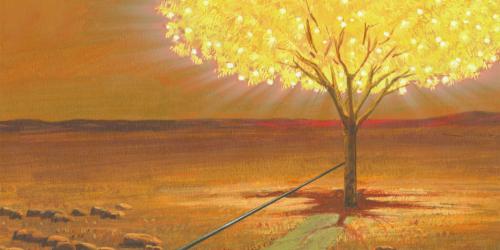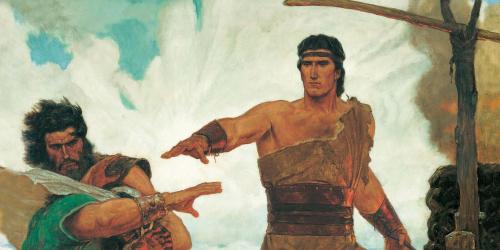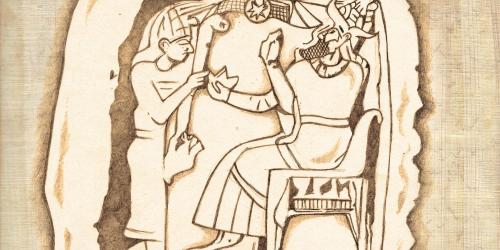You are here
Book of Mormon Central is in the process of migrating to our new Scripture Central website.
We ask for your patience during this transition. Over the coming weeks, all pages of bookofmormoncentral.org will be redirected to their corresponding page on scripturecentral.org, resulting in minimal disruption.
Gospel Doctrine Lesson #3: The Vision of the Tree of Life

Scripture Block
1 Nephi 8-11, 12, 15
Lehi's and Nephi's dream-vision of the tree of life serves as a lesson and encouragement about Christ's Atonement. In fact, the vision can be seen as the foundation of the Book of Mormon being centered on Christ.
Lesson Manual
KnoWhys

What Fruit is White?
1 Nephi 8:11

Why Did Nephi Write His Small Plates?
1 Nephi 9:4

Did Pre-Christian Prophets Know About Christ?
1 Nephi 10:17
Articles
People and Symbols in the Vision of the Tree of Life
"The Book of Mormon as an Ancient Book," by C. Wilfred Griggs, BYU Studies, Volume 22, no. 3
How does the Book of Mormon compare with ancient Egyptian and Greek texts that were written as guides for faith adherents of their respective sacred traditions? This classic article shows that Lehi's record, which was written to guide those who wish to be redeemed by Christ and find the path to the Tree of Life, has a demonstrable compatibility with the ancient Near Eastern origin which it itself claims. Its message retains enormous significance in a modern setting and cannot be ignored or taken lightly.
"The Presence of the Lord,"(link is external) by Jennifer C. Lane, The Things Which My Father Saw: Approaches to Lehi's Dream and Nephi's Vision(link is external)
Lehi's dream in 1 Nephi 8 has been interpreted in many rich and helpful ways. Most commonly we see it through the lens of Nephi's vision in 1 Nephi 11 or Nephi's explanation to his brothers in 1 Nephi 15, but this paper explores the insights we can gain by seeing the dream of the tree of life through conceptual framework expressed by Lehi's comments. A careful study of Lehi's response to his dream can help us see what it means not only to him but also to all of us more universally.
"Sacrifice and Condescension: Types and Shadows for Latter-day Living,"(link is external) by D. Mick Smith, The Things Which My Father Saw: Approaches to Lehi's Dream and Nephi's Vision(link is external)
Almost any reader of the Book of Mormon is aware of the greatness of Lehi's dream of the tree of life and Nephi's subsequent vision. Yet how many have truly pondered the extent of doctrinal teaching available from an in-depth study of these spiritual experiences? Do we see the Atonement of Christ spelled out in magnificent clarity? Do we grasp the complex yet simple narrative of how the Son would sacrifice and condescend as part of his mission to save us? Do we comprehend how this dream and vision set an example for us to follow as part of our daily personal covenants for latter-day living? Our purposes must be to discover what doctrine is taught through these experiences and how the lessons learned have application in our lives.
"Lehi Dreamed a Dream: The Report of Lehi's Dream in Its Biblical Context,"(link is external) by Dana M. Pike, The Things Which My Father Saw: Approaches to Lehi's Dream and Nephi's Vision(link is external)
The account of Lehi's dream in 1 Nephi 8 has great significance in the Book of Mormon as a whole due to its length and detail, its warning about the spiritual status of Lehi's family, and its focus on the beauty and power of Christ's Atonement. These features, combined with this dream's prominent location early in the Book of Mormon, raise intriguing questions about dreams and revelation. Is it significant that this major revelation came to Lehi in a dream? Were dreams a legitimate and frequent means of revelation in ancient Israel? Is the report of Lehi's dream in 1 Nephi 8 similar to reports of revelatory dreams in the Bible? If so, how can understanding biblical dream reports help us better appreciate the account of Lehi's dream, his family's reactions to it, and the role it plays in the greater whole of the Book of Mormon? This article strives to answer these questions.
"Nephi and His Asherah,"(link is external) by Daniel C. Peterson, from Journal of Book of Mormon Studies, Volume 9, no. 2(link is external)
Asherah was the chief goddess of the Canaanites. She was El's wife and the mother and wet nurse of the other gods. At least some Israelites worshipped her over a period from the conquest of Canaan in the second millennium before Christ to the fall of Jerusalem in 586 bc (the time of Lehi's departure with his family). Asherah was associated with trees—sacred trees. The rabbinic authors of the Jewish Mishna (second–third century ad) explain the asherah as a tree that was worshipped.
In 1 Nephi 11, Nephi considers the meaning of the tree of life as he sees it in vision. In answer, he receives a vision of "a virgin, . . . the mother of the Son of God, after the manner of the flesh." The answer to his question about the meaning of the tree lies in the virgin mother with her child. The virgin is the tree in some sense and Nephi accepted this as an answer to his question.
As an Israelite living at the end of the seventh century and during the early sixth century before Christ, he recognized an answer to his question about a marvelous tree in the otherwise unexplained image of a virginal mother and her divine child—not that what he saw and how he interpreted those things were perfectly obvious. What he "read" from the symbolic vision was culturally colored. Nephi's vision reflects a meaning of the "sacred tree" that is unique to the ancient Near East. Asherah is also associated with biblical wisdom literature. Wisdom, a female, appears as the wife of God and represents life.
"Lehi's Dream and Nephi's Vision: Apocalyptic Revelations in Narrative Context," by Matthew S. Stenson, BYU Studies, Volume 51, no. 4
Apocalyptic literature is an ancient literary genre. Isaiah 49:23–26 portrays the Lord as a divine warrior. This theme of the Lord as a divine warrior protective of his people is also used extensively by the early Nephite prophets in their teachings to describe the eschatological dualism between righteousness and wickedness that will exist in the last days. This passage, quoted both by Nephi (1 Ne. 21:23–26) and Jacob (2 Ne. 6:6 18), is in a way as messianic and apocalyptic in content and symbolic quality as are the biblical books of Daniel, Zechariah, and Revelation.

